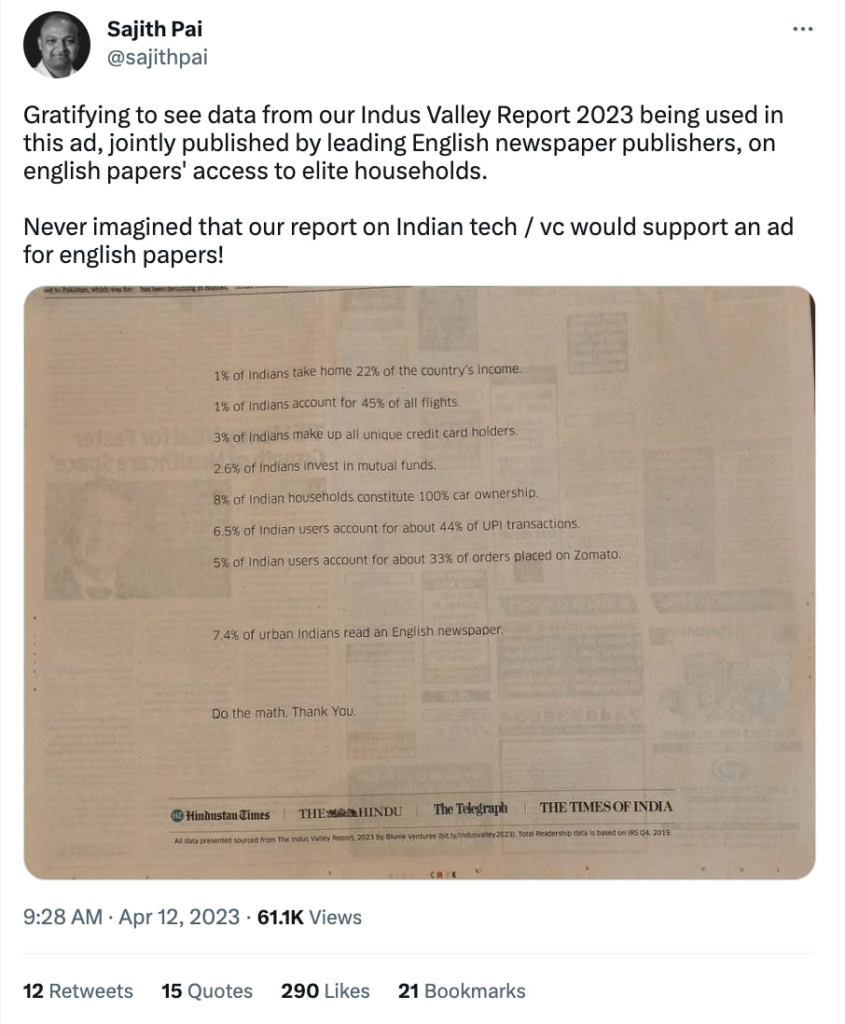The need for familiarity in an era of rapid change
Welcome to the eleventh edition of ‘3-2-1 by Story Rules‘.
A newsletter recommending good examples of storytelling across:
• 3 tweets
• 2 articles, and
• 1 long-form content piece
Each would be accompanied by my short summary/take and sometimes with an insightful extract.
Let’s dive in.
🐦 3 Tweets of the week

Public libraries can have massive impact over decades – I wish we had more of these in India.

Clever use of an insight to advertise English newspapers as a group.

-Stunning visual that shows how important iron ore has been among all metals.
📄 2 Articles of the week
a. The age of average by Alex Murrell
A fascinating article that points to our need for familiarity in a world where change happening too fast. Here’s some evidence of the preponderance of sameness in Hollywood:
In the late 1990s, 75% or less of the best-selling video games were franchise instalments. Since 2005, it’s been closer to 100%.
Is the homogenisation of Hollywood a new phenomenon?
To find out Adam Mastroianni analysed the top 20 grossing films in every year since 1977 and coded whether each was part of a “multiplicity” (i.e. a sequel, prequel, franchise, spin-off, reboot etc.).
What he found was surprising:
“Until the year 2000, about 25% of top-grossing movies were prequels, sequels, spinoffs, remakes, reboots, or cinematic universe expansions. Since 2010, it’s been over 50% ever year. In recent years, it’s been close to 100%.”.
The article does a great job of collating (in some cases perhaps cherry picking) examples from a wide array of sectors including design, architecture, Instagram posts, Airbnbs, Twitter et al.
And finally it concludes with some thoughts on why it might be happening and what do we do about it:
There are many reasons why this might have happened.
Perhaps when times are turbulent, people seek the safety of the familiar. Perhaps it’s our obsession with quantification and optimisation. Or maybe it’s the inevitable result of inspiration becoming globalised.
Regardless of the reasons, it seems that just as Komar and Melamid produced the “people’s choice” in art, contemporary companies produce the people’s choice in almost every category of creativity.
But it’s not all bad news.
I believe that the age of average is the age of opportunity.
When every supermarket aisle looks like a sea of sameness, when every category abides by the same conventions, when every industry has converged on its own singular style, bold brands and courageous companies have the chance to chart a different course. To be different, distinctive and disruptive.
Hat/tip: Ashish Gala who shared this article with me
b. How it all Works by Morgan Housel
A slightly old one, but one which speaks to the above article on our need for familiarity.
Physical attractiveness is something everybody intuitively understands but struggles to put into words. What makes an attractive face? It’s hard to describe. You just know one when you see one.
Several studies have tried to crack the code, the most fascinating of which I think is the idea that average faces tend to be the most appealing.
Take 1,000 people and have a software program generate the average of their faces – an artificial face with the average cheekbone height, average distance between eyes, average lip fullness, etc. That image, across cultures, tends to be the one people are most likely to judge as the most attractive.
One evolutionary explanation is that non-average characteristics have the potential to be above-average risks to reproduction. They may or may not actually impact reproductive fitness, but it’s almost like nature says, “Why take a chance? Go for the average.”
People love familiarity. That’s true not just for faces but products, careers, and styles. It’s almost like nature’s risk-management system.
🎤 1 long-form listen of the week
a. The Persuaders – Anand Giridhardas on the ‘You Are Not So Smart’ podcast with David McRaney
In today’s polarised times, it may seem impossible to change a political opponent’s mind. But Anand Giridhardas argues, in his new book ‘The Persuaders’ that we must not give up on the task. Yes, it will be difficult, but it is essential. And it is possible.
Though this fascinating discussion is US-centric, the ideas are universal. Just because you think your political opponent is wrong, malicious, or even pure evil, it does not mean that you should stop engaging with the large middle. Anand shares stories of people who are trying to bridge the communication gap with empathy, heart and finely-honed skills.
That’s all from this week’s edition.
Photo by Chris Lawton on Unsplash








